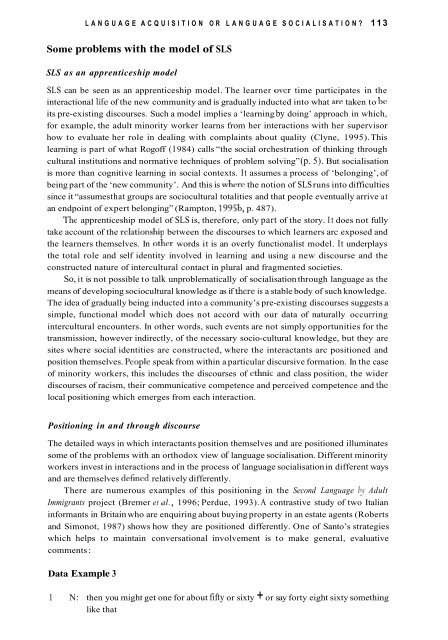English Language Teaching in its Social Context
English Language Teaching in its Social Context
English Language Teaching in its Social Context
Create successful ePaper yourself
Turn your PDF publications into a flip-book with our unique Google optimized e-Paper software.
LANGUAGE ACQUISITION OR LANGUAGE SOCIALISATION? 113Some problems with the model of SLSSLS as an apprenticeship modelSLS can be seen as an apprenticeship model. The learner ovcr time participates <strong>in</strong> the<strong>in</strong>teractional lifc of the new community and is gradually <strong>in</strong>ducted <strong>in</strong>to what arc taken to bc<strong>its</strong> pre-exist<strong>in</strong>g discourses. Such a model implies a ‘learn<strong>in</strong>g by do<strong>in</strong>g’ approach <strong>in</strong> which,for example, the adult m<strong>in</strong>ority worker learns from her <strong>in</strong>teractions with her supervisorhow to evaluate her role <strong>in</strong> deal<strong>in</strong>g with compla<strong>in</strong>ts about quality (Clyne, 1995). Thislearn<strong>in</strong>g is part of what Rogoff (1 984) calls “the social orchestration of th<strong>in</strong>k<strong>in</strong>g throughcultural <strong>in</strong>stitutions and normative techniques of problem solv<strong>in</strong>g” (p. 5). But socialisationis more than cognitive learn<strong>in</strong>g <strong>in</strong> social contexts. It assumes a process of ‘belong<strong>in</strong>g’, ofbe<strong>in</strong>g part of the ‘new community’. And this is wherc the notion of SLS runs <strong>in</strong>to difficultiess<strong>in</strong>ce it “assumes that groups are sociocultural totalities and that people eventually arrive atan endpo<strong>in</strong>t of expert belong<strong>in</strong>g” (Rampton, 1995b, p. 487).The apprenticeship model of SLS is, therefore, only part of the story. It does not fullytake account of the rclationship between the discourses to which learners arc exposed andthe learners themselves. In other words it is an overly functionalist model. It underplaysthe total role and self identity <strong>in</strong>volved <strong>in</strong> learn<strong>in</strong>g and us<strong>in</strong>g a new discourse and theconstructed nature of <strong>in</strong>tercultural contact <strong>in</strong> plural and fragmented societies.So, it is not possible to talk unproblematically of socialisation through language as themeans of develop<strong>in</strong>g sociocultural knowledge as if thcre is a stable body of such knowledge.The idea of gradually be<strong>in</strong>g <strong>in</strong>ducted <strong>in</strong>to a community’s pre-exist<strong>in</strong>g discourses suggests asimple, functional model which does not accord with our data of naturally occurr<strong>in</strong>g<strong>in</strong>tercultural encounters. In other words, such events are not simply opportunities for thetransmission, however <strong>in</strong>directly, of the necessary socio-cultural knowledge, but they aresites where social identities are constructed, where the <strong>in</strong>teractants arc positioned andposition themselves. Pcople speak from with<strong>in</strong> a particular discursive formation. In the caseof m<strong>in</strong>ority workers, this <strong>in</strong>cludes the discourses of cthnic and class position, the widerdiscourses of racism, their communicative competence and perceived competence and thclocal position<strong>in</strong>g which emerges from each <strong>in</strong>teraction.Position<strong>in</strong>g <strong>in</strong> and through discourseThe detailed ways <strong>in</strong> which <strong>in</strong>teractants position themselves and are positioned illum<strong>in</strong>atessome of the problems with an orthodox view of language socialisation. Different m<strong>in</strong>orityworkers <strong>in</strong>vest <strong>in</strong> <strong>in</strong>teractions and <strong>in</strong> the process of language socialisation <strong>in</strong> different waysand are themselves def<strong>in</strong>cd relatively differently.There are numerous examples of this position<strong>in</strong>g <strong>in</strong> the Second <strong>Language</strong> Ly AdultImmigrants project (Bremer et al., 1996; Perdue, 1993). A contrastive study of two Italian<strong>in</strong>formants <strong>in</strong> Brita<strong>in</strong> who are enquir<strong>in</strong>g about buy<strong>in</strong>g property <strong>in</strong> an estate agents (Robertsand Simonot, 1987) shows how they are positioned differently. One of Santo’s strategieswhich helps to ma<strong>in</strong>ta<strong>in</strong> conversational <strong>in</strong>volvement is to make general, evaluativecomments :Data Example 31 N: then you might get one for about fifty or sixty + or say forty eight sixty someth<strong>in</strong>glike that












